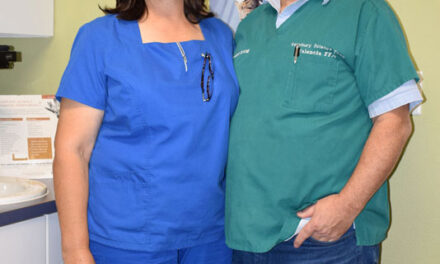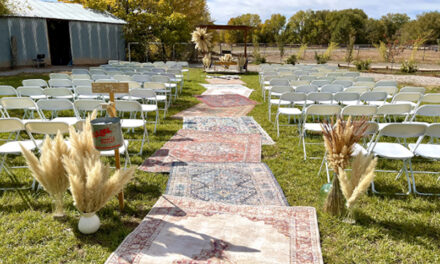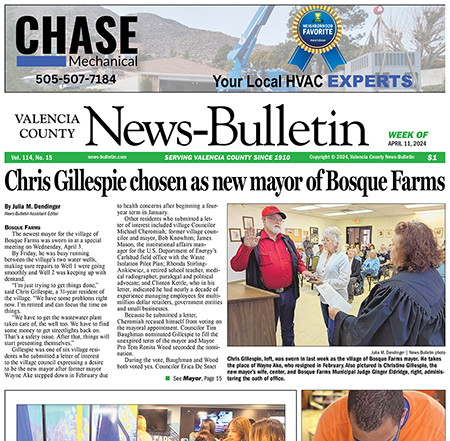Tomé
At the Tomé Camposanto, wooden crosses mark the graves of some of the area’s original settlers.
Joining their simple markers are modern cement crosses, decorative iron gates, statues and offerings of flowers, candles and teddy bears.
A committee from Immaculate Conception Catholic Church cares for the cemetery as church members have since people were first buried there in the 1600s.
But the committee worries that their camposanto — field of saints — will be affected by a nearby sewer plant that is owned by Rio Grande Utilities.
The plant, which has been in operation since the mid-1980s, serves residents of nearby housing developments, the University of New Mexico-Valen-cia Campus and several elementary and middle schools.
“It doesn’t take a genius to see that it’s very disrespectful. The cemetery has been there for hundreds of years. Why did they place it (the sewer plant) there?” asked Ramon Torres, who heads the cemetery committee. “And they have plans for expansion. What will it be like in 50 years or 100 years from now? If they don’t do something now, what happens when it gets bigger? It should be moved before they put more expansion into it. It’s holy land. We will not give up. Putting a sewer plant next to a graveyard is uncalled for. Our goal is to have that thing closed and moved out of there. It’s totally disrespectful.”
Torres and members of the Tomé-Adelino Neighborhood Association charge that, in July, untreated water from the sewer plant leaked into the place where their ancestors are buried.
But Bob Davey, president of the Valley Improvement Association (a non-profit neighborhood association), which holds a majority of stock in the Rio Grande Utilities Corporation, said it is impossible for untreated sewer water to leak into the graveyard because of the way the plant is constructed.
And he says strict state and federal regulations governing the plant would make it almost impossible for any untreated water to get into the cemetery — or to any nearby development.
Members of the Tomé-Adelino Historic Neighborhood Associa-tion insist that there have been times when visitors smelled sewer odors and saw untreated sewer water on the graves. Pictures they took show water flooding graves, although there is no solid matter evident in the water.
But they wonder if the structures of the graves will be affected by the water.
Flavio Perea, an association member, says while he attended a ceremony at the cemetery “there was an odor of human fecal matter.”
The cemetery was part of the original Spanish land grant from the 1700s, Torres said. Church records begin in 1739, and thousands of people are buried here — and their descendants continue to make their final resting places here.
The cemetery is surrounded by a row of Arizona pine trees. Behind the eastern row of trees sits the sewer plant.
Tomé residents wonder why the plant was placed so close to the cemetery.
“We know it has to happen, but not next to our camposanto,” said Rita Padilla-Gutierrez, president of the neighborhood association. “We’re not against sewer plants. Something has to be done to connect the valley. Sewage plants are needed, but not next to an ancestral burial ground.”
“Engineers saw that the university was going there. They saw development to the east and chose a low spot for the gravity. There was no intentional effort to insult people from Tomé,” said Davey. “Engineers recommended the spot.”
Padilla-Gutierrez said residents knew there was a building east of the cemetery, but did not know what it was for many years. And they say that, when it was built, they did not know about hearings held for public comment.
Ironically, the flooding of the cemetery in July happened when residents, who had asked to use “treated” water from the sewer plant for irrigation, left a valve on by mistake.
In 1998, the cemetery committee asked to use “treated” water (which is safe for irrigating, but not for drinking) from the sewage plant to irrigate trees at the cemetery. Davey agreed and the VIA set up a system of hoses and valves to enable the cemetery committee to use treated sewer water for irrigation.
“On July 17, (2001), some of the cemetery maintenance committee confronted Bobby Towle, (sewer plant manager) and accused us of dumping overflow onto the cemetery. That evening, Ray Garcia (an association member) and Rita Padilla-Gutierrez appeared before the county commission with pictures,” Davey said. “We went out and looked at the area. Obviously, the irrigation system had been the cause of it. On July 24, Ramon Torres (chairman of the cemetery maintenance committee) called us. They’d left it (the water) on and he apologized.”
Padilla-Gutierrez, said “the valve clogged up because of the thickness of the sewage.”
But Davey disagrees.
“They jumped to conclusions,” he said. “They had trouble with a clogged valve they thought was clogged with sewage. No, it was clogged with algae. It was absolutely physically impossible for the raw sewage to get in there. We’re operating under a federal permit.”
Soon after that incident, Davey wrote the pastor at Immaculate Conception Church saying “we had to take them off the water system because of the complaints from the neighborhood association at the county commission.”
The sewer plant was built in 1985-86 and opened in 1986 to coordinate with UNM’s opening, Davey said. It was approved by the State Environment Department. A legal announcement appeared in the newspaper then about plans for the construction of the plant, and nobody protested the construction and the granting of a permit, Davey said. Engineers planned the plant, placing it to serve additional housing developments.
“We should have done something 12 years ago,” said Perea.
The customers of the sewer plant include 600 families in Las Maravillas, Las Pasitos del Cielo, the Valencia Campus, several elementary schools and intermediate schools.
The plant does not benefit the people of Tomé or of Adelino, residents point out. But they could be accommodated in the future, Davey said.
The cemetery committee would like the sewer plant moved to another location, but, Davey said, this would cost the company too much — $2 to $3 million to tear it down and rebuild it.
Padilla-Gutierrez and members of the association said in a letter that, if the VIA and Rio Grande Utility Company “want to continue to be ‘good neighbors,’ it is incumbent upon them to do the right thing and relocate this impending threat to the people of the affected areas, to their quality of life and to the memory of their loved ones.”
Tomé residents ask that the plant go to another part of the 47,000 acres surrounding the area which, they say, “VIA owns.” But Davey said that is misleading. The VIA owns about 10,000 acres “and much of it is near the mountains, and you can’t put a plant there,” he said.
And about 6,000 acres of that 10,000 is for schools and parks in the future, he added.
Much of the land had been plotted for subdivisions years ago.
Tomé residents are concerned that the plant will expand in the future as development occurs. But, Davey said, this would not happen for a long time because the plant is working at 60 percent of its capacity. The system could add another 500 to 600 homes.
And the VIA is looking at alternatives to expansion of the plant, including building several small plants.
Another concern of the Tomé residents is that VIA is planning to sell the sewer plant to a California company. Rio Grande Utilities has applied to the State Public Regulation Commission for a permit to allow the sale of the plant.
Members of the association appeared at a recent meeting of the Public Regulation Commission to protest the sale.
“Why should a CEO in San Jose, Calif., care about Hispanic farmers in New Mexico?” Padilla-Gutierrez asked.
In attempting to allay these concerns, Davey said, “They will not bring in their own people. The day-to-day affairs will be run by people in New Mexico. They will have the same recourse to the PRC and federal agencies they do now.”
In addition, VIA announced its plan to sell the utility in newsletters and in a mailer to its customers.
The utility company also is asking for a 15 percent increase in water rates, which Davey said would be the first increase since 1989.
But the committee is concerned about what will happen in the future — and says that this site should remain sacred, the final resting place of generations of New Mexicans who’ve loved this land. “It scares me what it looks like today and what it will look like in 50 years,” Padilla-Gutierrez said.
Torres said: “Let the next generation know. We want it on record that we fought it. This cemetery is no different from Arlington National Cemetery. They would not put a sewer plant next to Arlington.”














